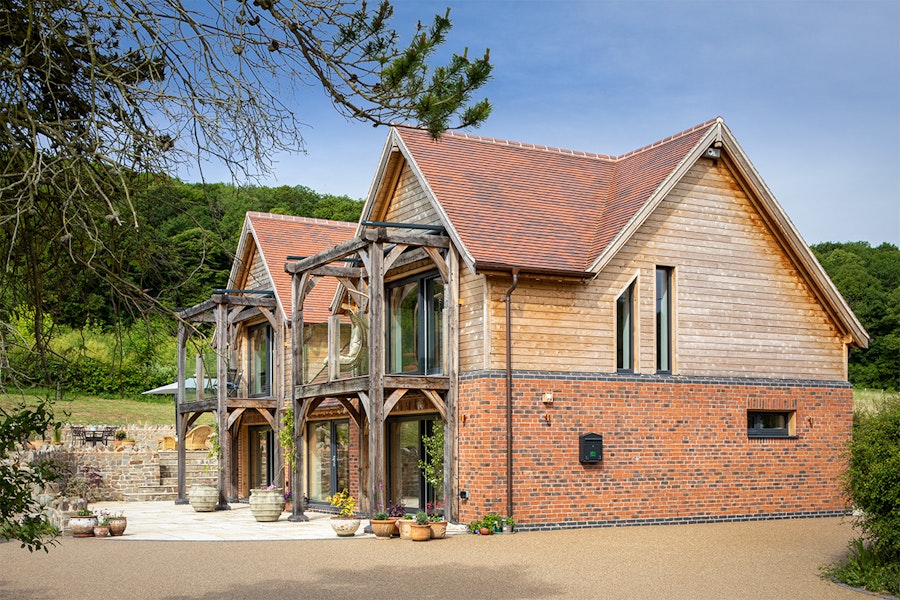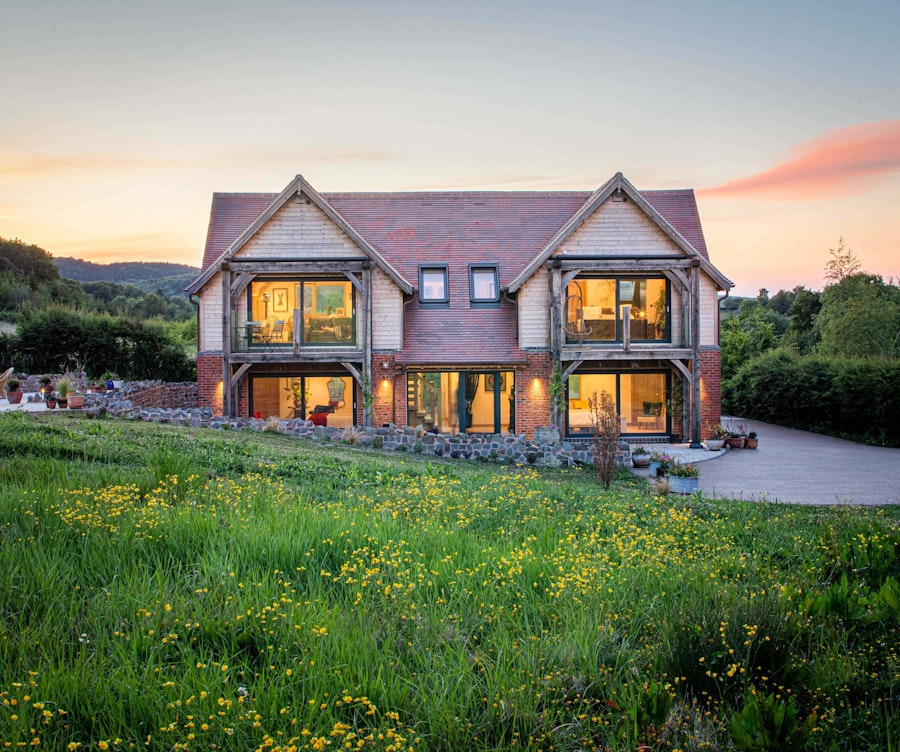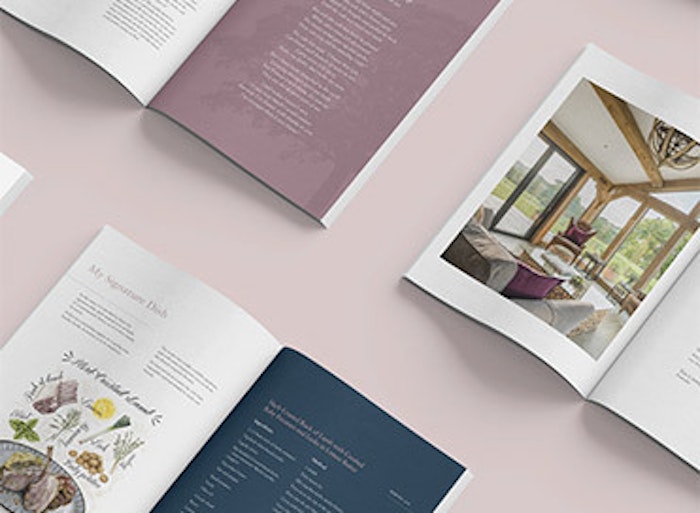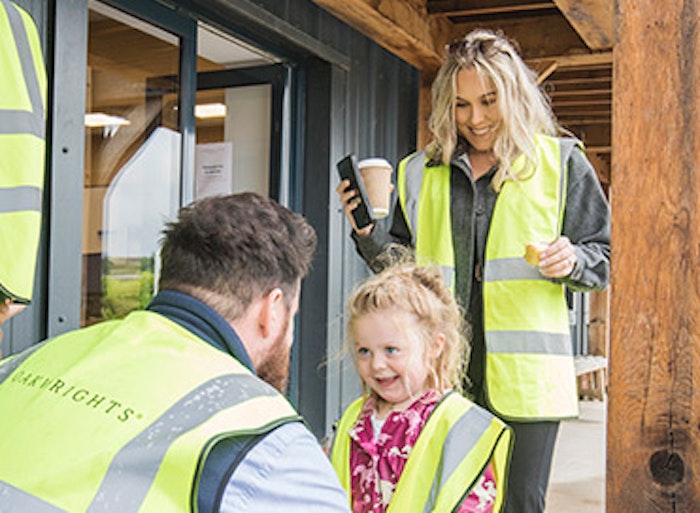
The UK’s first certified oak frame Passivhaus Bed and Breakfast in Worcestershire
Introduced to the Passivhaus concept by our Founder Tim Crump, Andrew and Linda took the idea by the horns and created their stunning oak framed Passivhaus B&B, the first of its kind!
Project Details
- Worcestershire
- 2019
- Passivhaus
- 258m²
- £698,658
- Self-build
- 3
Andrew and Linda Burnett owned a 1970’s property in Kent where they lived together for seven years. Looking to the future, they wanted to relocate and had always dreamt of running a Bed and Breakfast, so, they began searching for suitable properties on the market in and around Malvern; a spa town in Worcestershire where Linda grew up.
Andrew and Linda visited numerous properties, some of which were barn conversions. They admired the exposed timber beams present inside, however, struggled to find anything that met their requirements. Undeterred, the notion of building instead of buying came to the fore; a thought that had crossed Andrew’s mind for years.
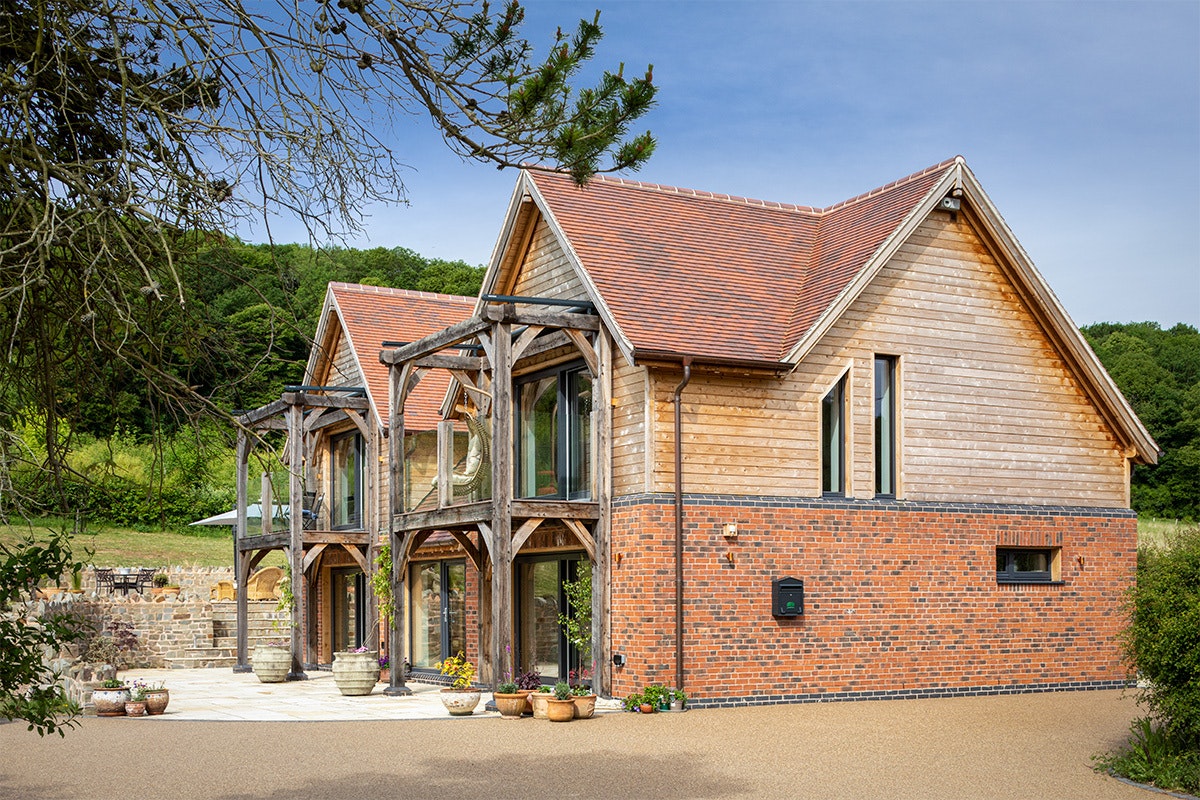
Choosing to build an oak frame Passivhaus home
Choosing to build an oak frame Passivhaus home
“From our point of view, there is an ambiance about an oak frame building which you don’t get from other buildings,” smiles Andrew. “We find oak interesting, and just like a central fireplace, see it as a feature of a home; living and changing over time.”
In 2014, Andrew and Linda kickstarted their home building journey by visiting national self-build exhibitions.
“We visited Oakwrights’ stand and a number of other oak frame providers at an NEC exhibition,” says Andrew. “Oakwrights appealed to us in terms of what they were proposing but also because of the explanation we received about their premium eco-insulated panel systems. The other suppliers we had spoken to said they could help us with the frame, but everything else was up to us!”

Self-build research
Self-build research
The Burnetts discussed their ideas with our Founder, Tim Crump, who introduced them to ‘Passivhaus (Passive House) design.’ Intrigued, Andrew and Linda went away to learn more about this low energy building performance standard, before visiting us and our show home in Herefordshire, where they explored, experienced and took pictures of the oak frame.
“We had booked a stay at The Woodhouse,” explains Linda. “The next day we remember saying to ourselves, ‘This is it; we can’t build anything else!’”
With their hearts firmly set on building with oak, Andrew and Linda focused their attentions towards Passivhaus design. What initially appealed to them about Passivhaus is the reward of exceptionally low heating bills.
“I am conscious energy costs will continue to rise, and with this, I came to see from a heating bill point of view that building a Passivhaus was like a pension,” explains Andrew, “where you invest a moderately large sum of money into the build, and receive extremely low heating bills for as long as you live there in return. We look at it as a capital investment now to save money in the future.”
Andrew and Linda visited the UK’s first certified oak frame Passivhaus home in Yorkshire, which our teams supplied the bespoke oak frame for. The Burnetts observed a noticeable difference in the way the internal environment felt in comparison to other houses and gained a first-hand insight into achieving Passivhaus certification.
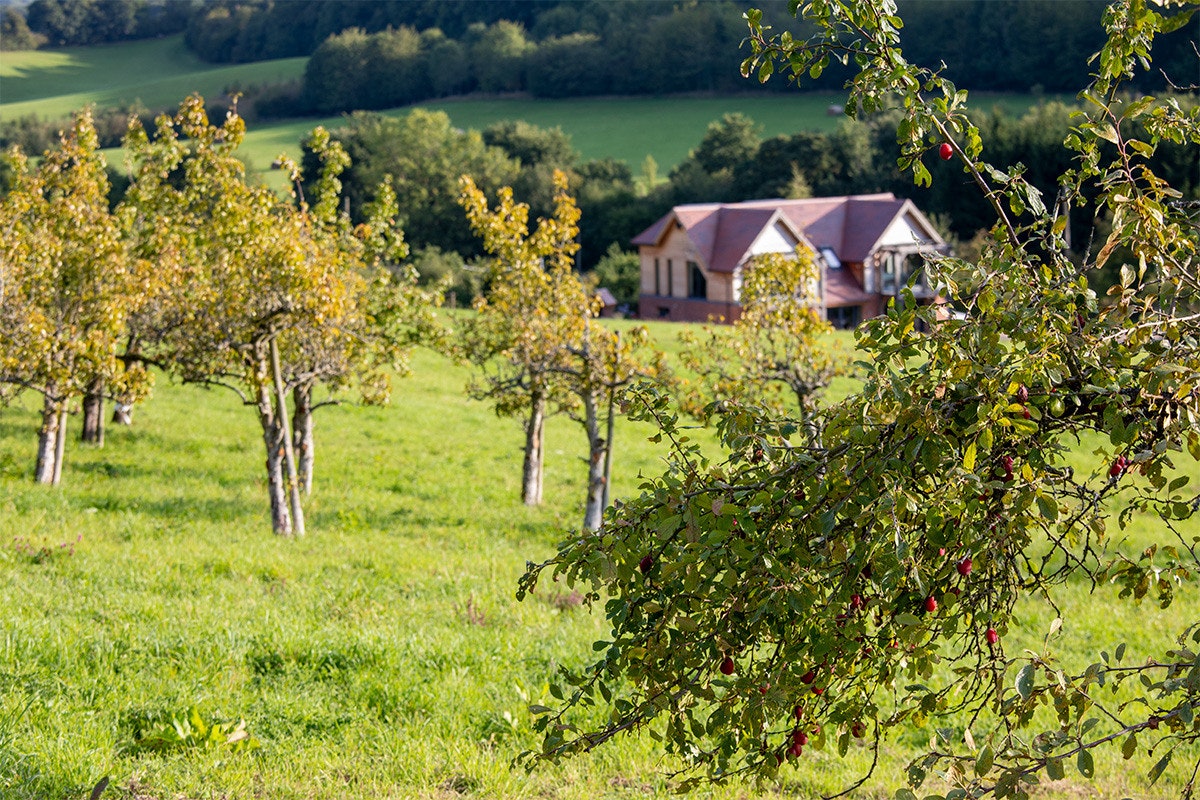
Finding the perfect plot
Finding the perfect plot
Andrew and Linda found a house to rent in Malvern and relocated. On a full-time basis, Linda devoted her efforts to plot finding, and after a year of searching, her perseverance was rewarded.
In 2016, the Burnetts visited an eight-acre plot with planning permission attached for a two storey, four bedroom house. Situated in a designated National Landscape, positioned between the Malvern and the Suckley Hills, Andrew and Linda fell in love with the surrounding countryside and tranquil, woodland backdrop. They envisaged themselves being members of the close-knit community there, so unsurprisingly, they made an offer and this was accepted in October.
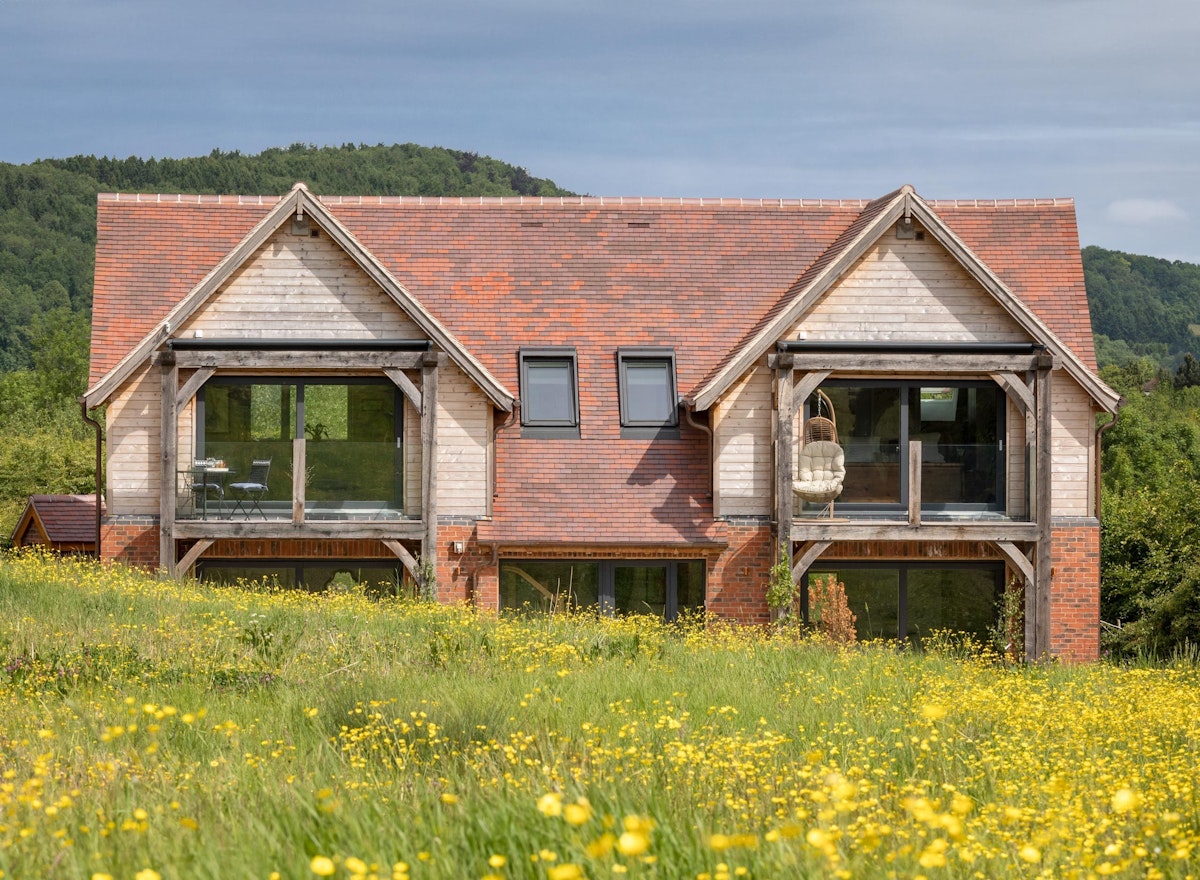
Key design features
Key design features
“Andrew and Linda were determined to create a build that met Passivhaus standards, so, I worked with them to develop their design holistically,” explains David Bryan, a Certified Passive House Consultant within our in-house Architectural Design team, who designed the Burnetts’ home and submitted their approved planning application. Please click here to read David’s planning consent story for this unique project.
A scenic drive down a country lane leads you to Andrew and Linda’s home, where your eyes are drawn to the varying shapes and heights achieved within Andrew and Linda’s architectural design, including two striking, south-facing gable ends. A complementary exterior material palette comprising red bricks and bonding to mirror the surrounding properties, Western Red Cedar weatherboarding and a rustic tile roof subtly enhance these features, while blending their home into its setting.
Greeted by the south elevation on arrival, four large, triple glazed lift and slide doors have been strategically positioned alongside a large, triple glazed front door and two rooflights, so the Burnetts’ Passivhaus home harnesses the benefits of natural sunlight. There are many cleverly shaped windows on other aspects of the property.
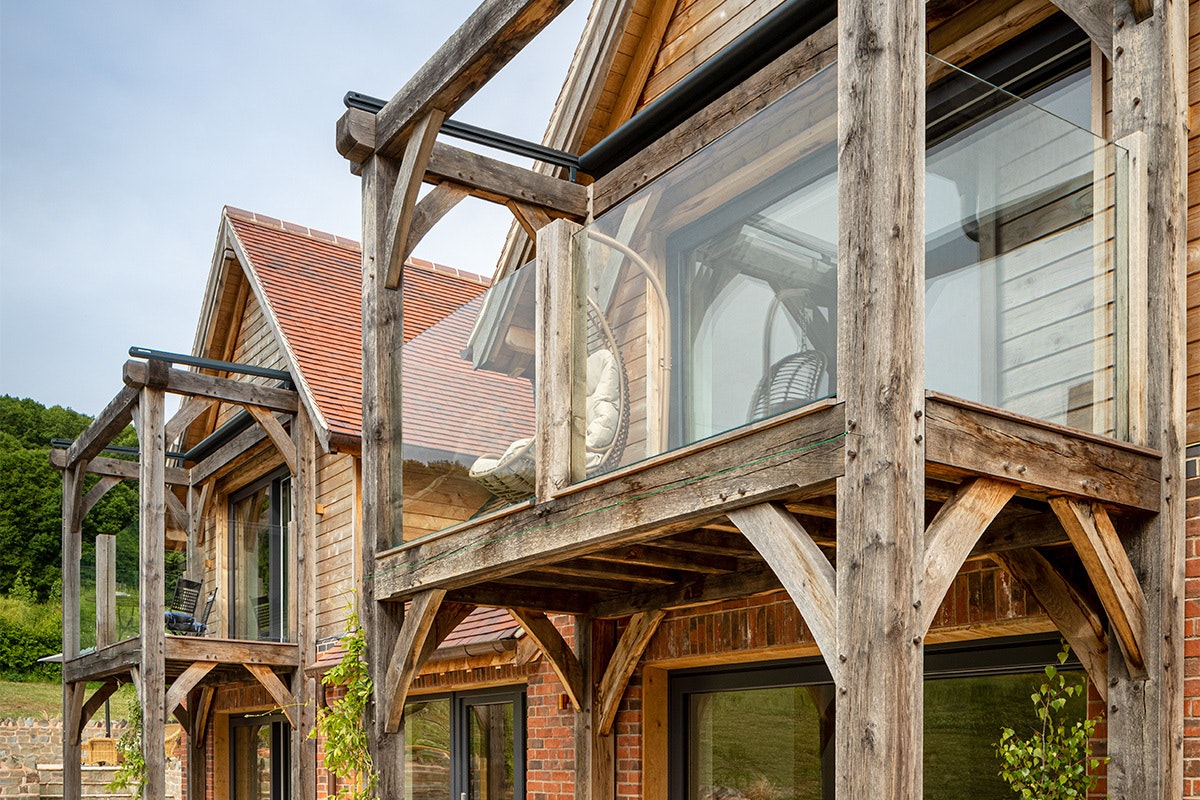
Natural light and balconies
Natural light and balconies
“Emphasis was also on positioning windows, doors and balconies to take in Andrew and Linda’s views,” explains Sarah Connelly, Andrew and Linda’s Frame Designer here at Oakwrights. “Instead of adding roofs to the balconies as you step out of the first floor doors, our clients left them open to enjoy all weather and added blinds atop to provide some dappled shading in the summer.”
The Burnetts’ 1970’s house in Kent had big windows and a spacious lounge with two patio doors, so they had always appreciated living with lots of natural light.
“We really loved The Woodhouse’s glazed gables,” says Linda. “We didn’t know what we could or couldn’t include but Dave created a brilliant design, and we didn’t really change anything.”
Andrew and Linda commissioned Green Building Store to supply their windows and doors, and are extremely complimentary of their products and customer service. The quality of these products and the precise installation was crucial for draught prevention, the reduction of thermal bridging around and beneath the window and door frames, and in turn, certification success.
“We were delighted to provide our high performance ULTRA triple glazed timber windows and doors for this exemplar oak timber frame Passivhaus project and we congratulate the clients and Oakwrights’ team,” replies Luke Gilman, Manager, Windows Department at Green Building Store. “We’re proud that our ULTRA range will have contributed to this project achieving Passivhaus certification.”

Step inside their home
Step inside their home
As you step into the Burnetts’ double-height hallway, the feeling could be likened to arriving ‘home,’ as you are welcomed by a warming peacefulness which resonates all the way to Andrew and Linda’s galleried landing above.
“A Passivhaus is tranquil inside; our plot and surroundings are tranquil outside,” says Andrew.
The Burnetts initially wanted a four bedroom home but later opted for three to ensure every room had plentiful light and space.
“Andrew and Linda were keen to have an upside-down interior layout to make the best views from their site, with the main living areas and an en-suite master bedroom, which benefits from a walk-in dressing room, upstairs,” explains David.
This design consideration has created the perfect setting for their Bed and Breakfast, as two, spacious en-suite double bedrooms are nestled downstairs. Here, guests can experience living in an oak framed Passivhaus home for themselves and if they would like, further their understanding of this standard, while ‘getting away’ and making the most of the countryside beyond the south-facing doors positioned within both bedrooms. The Burnetts’ exciting new venture is the UK’s first certified oak frame Bed and Breakfast; an opportunity you can discover more about here.
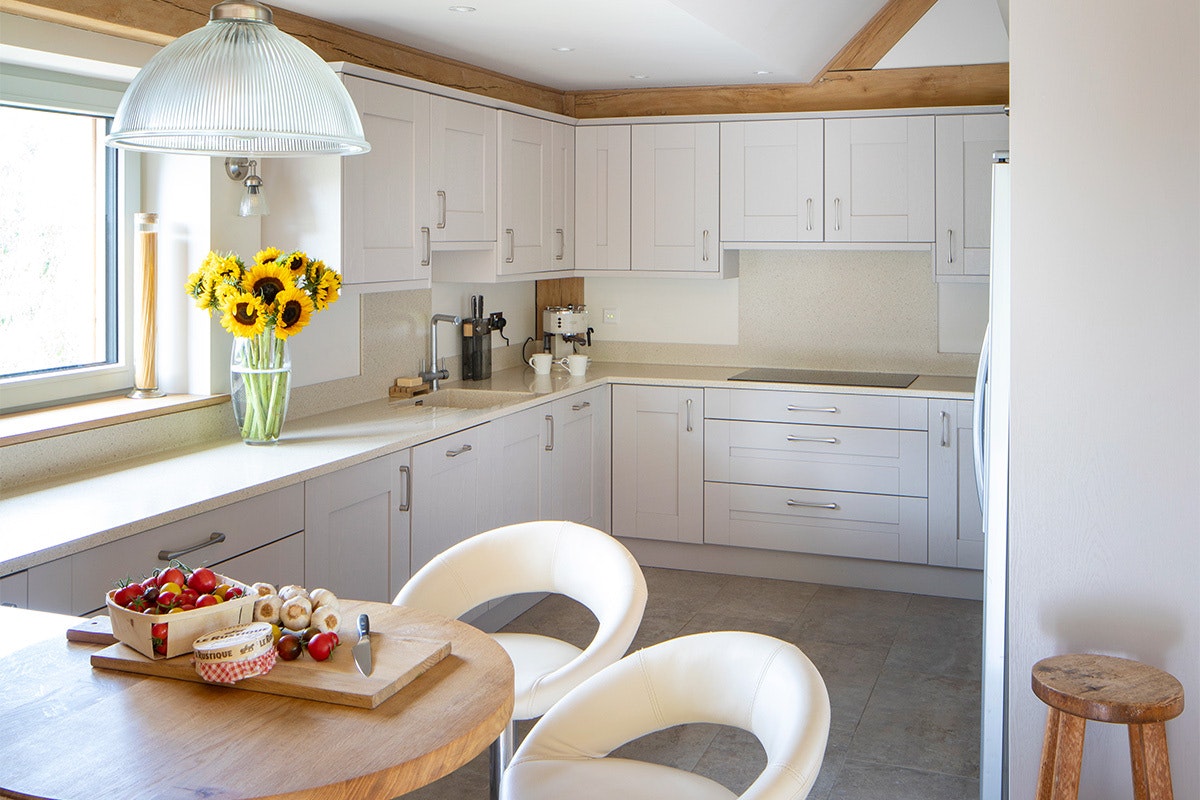
Topsy-turvy living
Topsy-turvy living
Travelling up Andrew and Linda’s bespoke oak Stairplan staircase, the beams on the first floor provide their home with the barn conversion-style they love. The sense of space continues upstairs, as you step into their open-plan, L-shaped kitchen/dining/living room.
“Andrew and Linda were keen to enjoy the benefits a Passivhaus brings,” says Sarah. “This meant truncating the oak frame where we’d normally see vaulted ceilings and full trusses, creating a unique aesthetic; wherever you look there’s interest.”
“I’m still fascinated with how small portions of exposed oak are seemingly isolated from the rest because of the internal walls,” continues Andrew. “We spent a lot of time designing our lighting to illuminate our frame, creating a different ambience in the evening in comparison to during the day.”
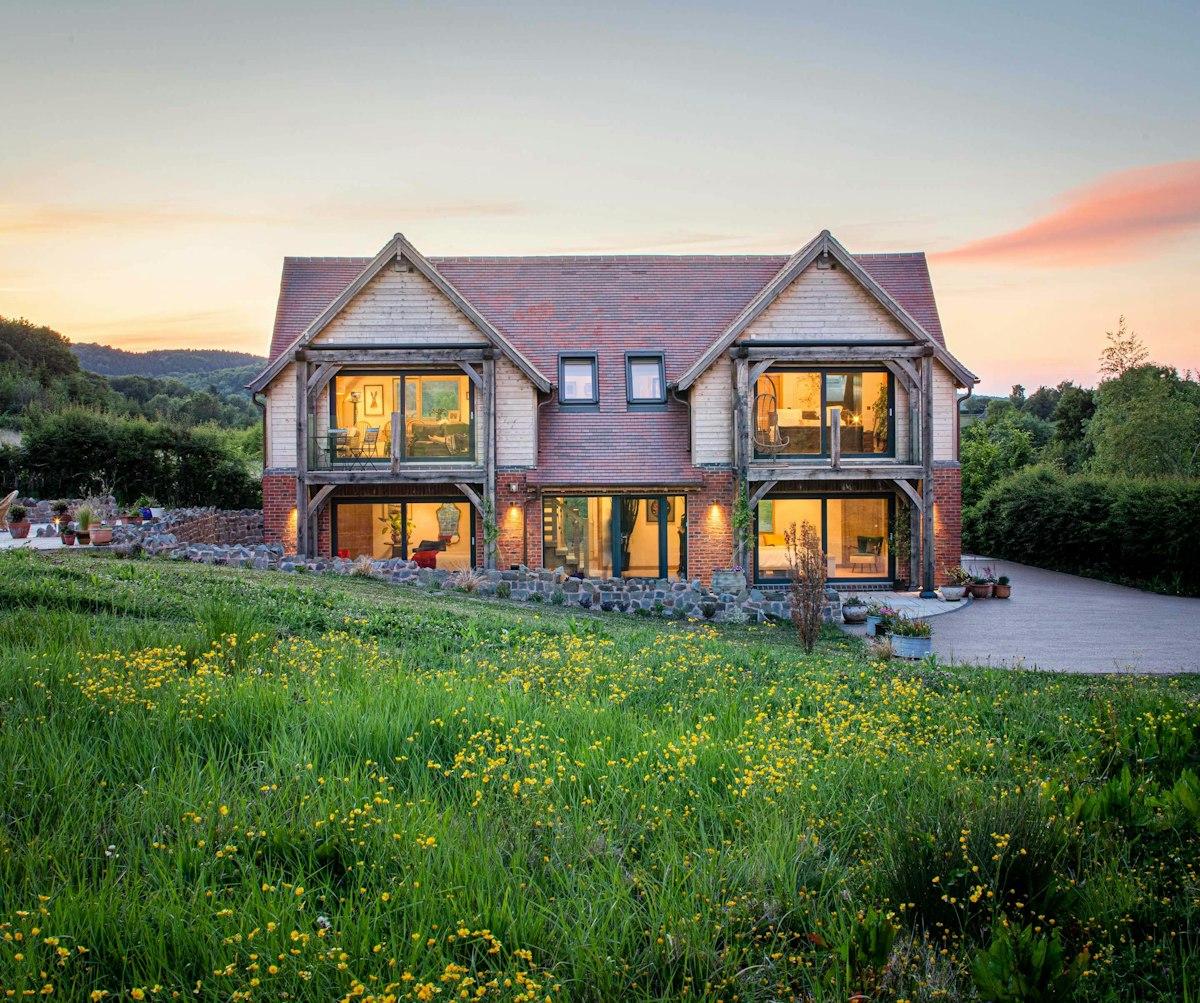

A certified oak frame Passivhaus meeting present and future needs
A certified oak frame Passivhaus meeting present and future needs
Most importantly, the design of the Burnetts’ home and Bed and Breakfast was developed around their desire to achieve Passivhaus certification. In conjunction with the evolving design, David used the Passive House Planning Package to determine the required performance calculations; a subject Andrew and Linda share their experiences of within this blog.
“An advantage of designing our Passivhaus and frame with Oakwrights was that Dave, Sarah, Craig Holden (a Business Development Manager here at Oakwrights) and Steven Laws (who designed their panel system), worked together under one roof,” says Andrew. “Based on our experience, my advice to someone wanting to build from scratch would be to design all aspects of their home with the same company. In my opinion, you are more likely to get a fantastic outcome.”
Andrew and Linda encased their oak frame with our WrightWall and WrightRoof premium eco-insulated panel system and Passivhaus-quality sealing tapes were used for optimum airtightness. To ensure fresh, temperature-controlled high indoor air quality all year round, a mechanical ventilation with heat recovery system (MVHR), designed and supplied by Green Building Store, was required to work alongside their panel system, and the Burnetts installed a ground source heat pump, taking heat from their field to warm up their hot water and when required, their home. In hotter months, a cooler battery helps to keep their home cool.
“Oakwrights’ WrightWall and WrightRoof Natural premium eco-insulated panel systems is inherently airtight so we felt confident it would assist us in achieving the stringent Passivhaus requirements,” explains Andrew.
The construction of Andrew and Linda’s Passivhaus home commenced in April 2018 and took just 11 months. The build was managed by Furber Young Developments, who were recommended to the Burnetts by Craig Holden.
“We knew from the very initial enquiry that this was going to be a special project to be involved with, says Martin Young, Director at Furber Young Developments. “Andrew and Linda had a clear vision of what they wanted to achieve and the standards of planning and workmanship required to achieve their ultimate goals. We embraced this approach from the outset and thoroughly enjoyed being an integral part of this build, alongside everyone involved: it was a real team effort.”
“Furber Young understood what we wanted to achieve,” continues Andrew, “and they worked extremely closely with us to ensure every detail was correct, with the end goal of the property attaining Passivhaus certification. They were absolutely great to work with throughout.”
Andrew and Linda’s planning and attention to detail from the outset is a testament to how smoothly their home building journey evolved to construct the house they proudly call their home.
“We came in on budget and a week ahead of schedule,” says Andrew. “I think the secret behind that was due to the vast amount of planning we undertook upfront and with Furber Young; once plans were in place, we changed nothing.”
“Because this is our forever home, it was important for the design to meet our needs now and later in life,” continues Linda. “For example, we have plans for a lift in our hallway should we need it.”
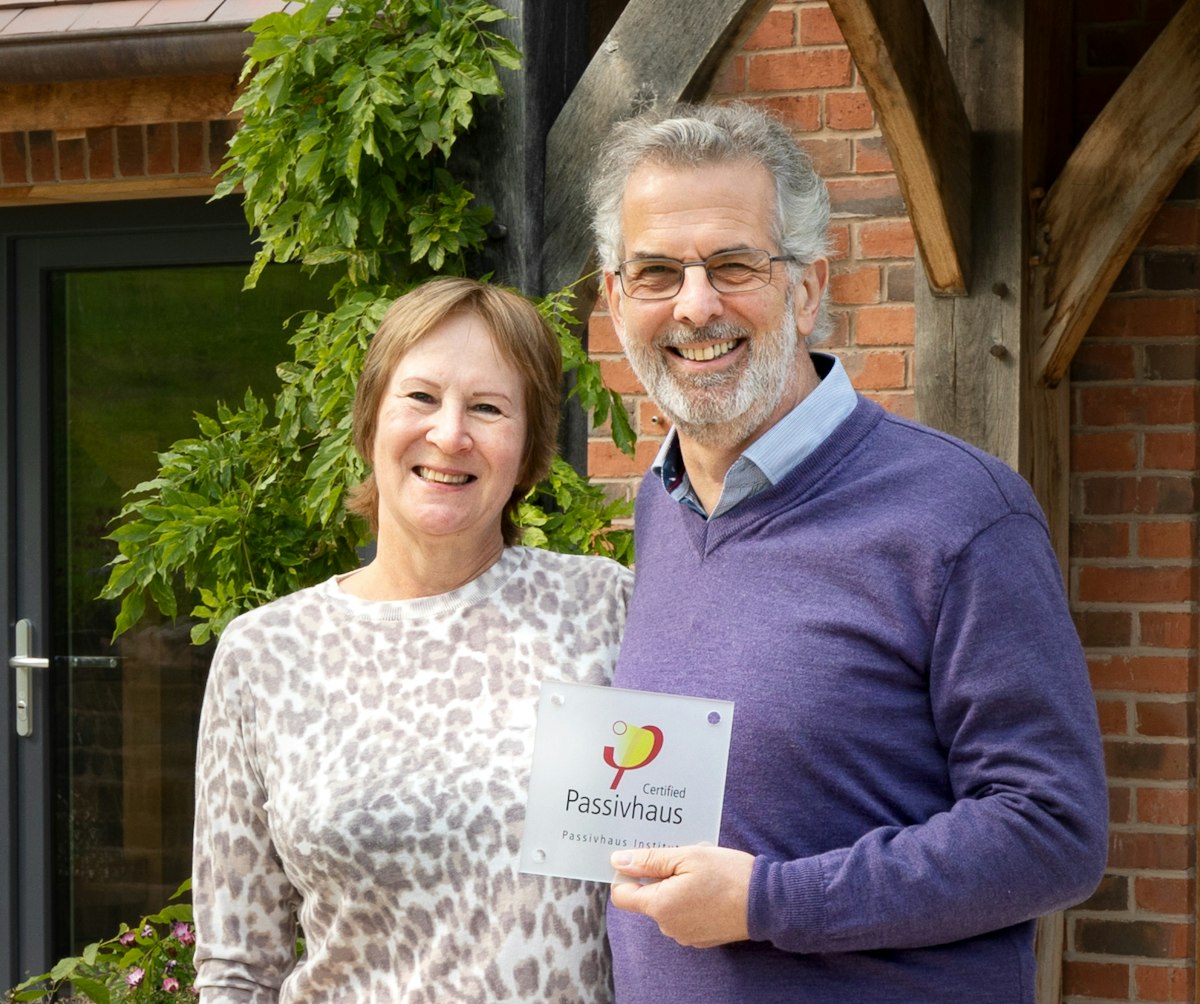
Certification
Certification
On 16th September 2019, the Burnetts received Passivhaus certification. Undoubtedly, they feel a huge sense of achievement. Furber Young, Green Building Store and our teams are thrilled to have been part of their exceptional journey. Andrew and Linda’s build is the first Passivhaus home, and indeed Bed and Breakfast, we have developed from the initial design through to certification.
“We were over the moon to receive certification and we couldn’t be happier with our home,” says Linda. “Every time we step inside, we still smile at each other and say, ‘Wow, it’s just lovely here!’”
“I find it relaxing to simply sit and look,” concludes Andrew. “We’re still enjoying the oak and we don’t anticipate getting tired of it. From a design that turned into a frame we saw being erected, to now living here: it is and will continue to be satisfying for us.”
We really loved The Woodhouse’s glazed gables. We didn’t know what we could or couldn’t include but Dave created a brilliant design, and we didn’t really change anything
We really loved The Woodhouse’s glazed gables. We didn’t know what we could or couldn’t include but Dave created a brilliant design, and we didn’t really change anything
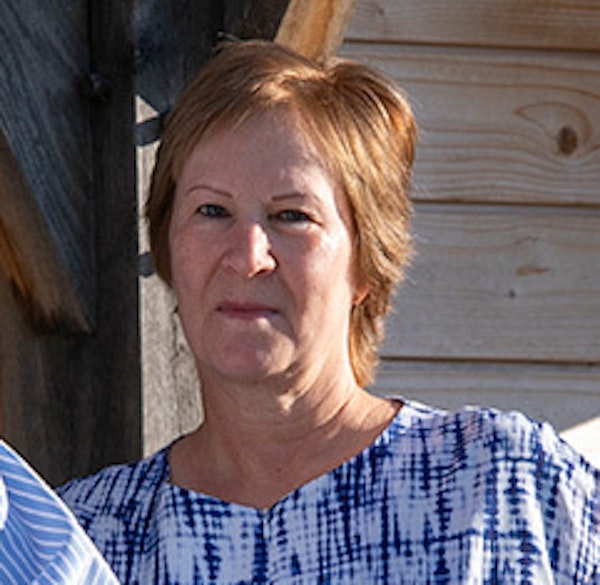
Linda
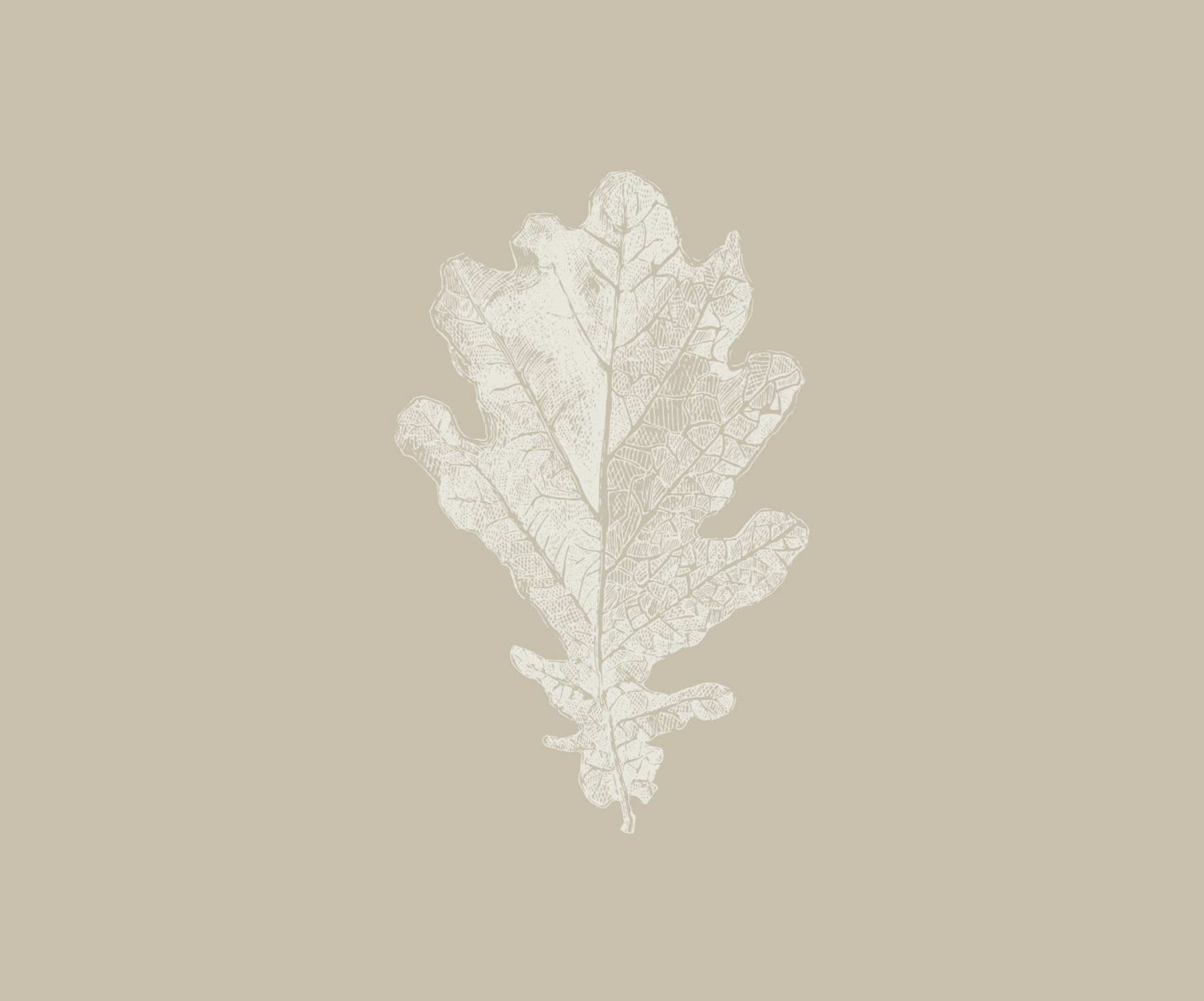

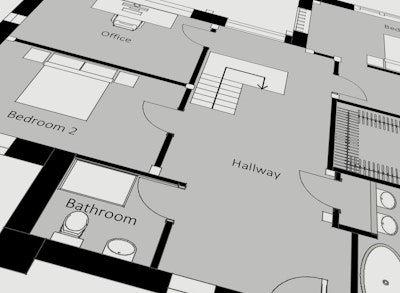
Download the floor plans for this home
Download PDF


